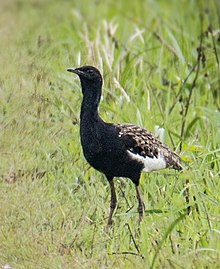Bengal florican
| Bengal florican | |
|---|---|

| |
| A male Bengal florican | |
| Scientific classification | |
| Domain: | Eukaryota |
| Kingdom: | Animalia |
| Phylum: | Chordata |
| Class: | Aves |
| Order: | Otidiformes |
| Family: | Otididae |
| Genus: | Houbaropsis Sharpe, 1893 |
| Species: | H. bengalensis
|
| Binomial name | |
| Houbaropsis bengalensis (Müller, PLS, 1776)
| |
| Synonyms | |
|
Eupodotis bengalensis (Gmelin, 1789) | |
The Bengal florican (Houbaropsis bengalensis), also called the Bengal bustard, is a bustard species native to the Indian subcontinent, Cambodia, and Vietnam. It is listed as Critically Endangered on the IUCN Red List because fewer than 1,000 individuals were estimated to be alive as of 2017.[1] It is the only member of the genus Houbaropsis.
Description

The male Bengal florican has a black
They are normally silent but, when disturbed, utter a metallic chik-chik-chik call. Displaying males croak and produce a deep humming sound.[2]
The only bird even remotely similar to adult males of the Bengal florican is the
Distribution and habitat

The Bengal florican has two disjunct populations. One occurs from
Bengal floricans live in open tall grassland habitats with scattered bushes. The most important grass species are
Status and conservation

Restricted to tiny fragments of grassland scattered across South and Southeast Asia, the Bengal florican is the world's rarest bustard. It is known to have become increasingly threatened by land conversion for intensive agriculture, particularly for dry season rice production. Poaching continues to be a problem in Southeast Asia, while the South Asian population is down to less than 350 adult birds, about 85% of which are found in India. Though more threatened, birds in Southeast Asia may number as many as in South Asia but more probably closer to or even less than 1,000 adults.[5]
The population has decreased dramatically in past decades. It may be that in India the decline is coming to a halt and that stocks in
In
In
The courtship display of males has been discussed by many
If firewood and timber is collected from grassland rather than from forests, human land use will even benefit the species. In particular,
References
- ^ .
- ^ ISBN 9781408127636.
- ISBN 978-0-19-566523-9.
- ^ BirdLife International (2009) Species factsheet: Houbaropsis bengalensis.
- ^ a b c BirdLife International (2008, 2009) Species factsheet: Houbaropsis bengalensis
- ^ a b c Baral, N.; Timilsina, N. & Tamang, B. (2003). "Status of Bengal Florican Houbaropsis bengalensis in Nepal" (PDF). Forktail. 19: 51–55.
- ^ a b Poudyal, L. P.; Singh, P. B. & Maharjan S. (2008). "The decline of Bengal Florican Houbaropsis bengalensis in Nepal" (PDF). Danphe. 17 (1): 4–6. Archived from the original (PDF) on 20 March 2014. Retrieved 2 March 2013.
- ^ Poudyal, L. P.; Singh, P. B. & Maharjan S. (2008). "Bengal Florican Houbaropsis bengalensis in Nepal: an update" (PDF). BirdingASIA (10): 43–47. Archived from the original (PDF) on 24 September 2015. Retrieved 2 March 2013.
- .
- ^ Baker, E. C. S. (1907). "The breeding of the Bengal Florican Sypheotis bengalensis". Journal of the Bombay Natural History Society. 17: 538–540.
Further reading
- Grimmett, R; Inskipp, C. and T. (1998). Birds of the Indian Subcontinent. ISBN 0-7136-4004-9
- BirdLife International (BLI) (2007). [ 2006-2007 Red List status changes ]. Retrieved 2007-AUG-26.
- BirdLife International (BLI) (2009). Bengal Florican Species Factsheet. Retrieved 2009-JUN-11.
- Gray, T. N. E; Collar, N. J; Davidson, P. J. A; Dolman, P. M; Evans, T. D; Fox, H. N; Chamnan H; Borey R; Hout, S. K; Van Zalinge R. N. (2009). Distribution, status and conservation of the Bengal Florican Houbaropsis bengalensis in Cambodia. Bird Conservation International (2009) 19: 1–14 PDF download

